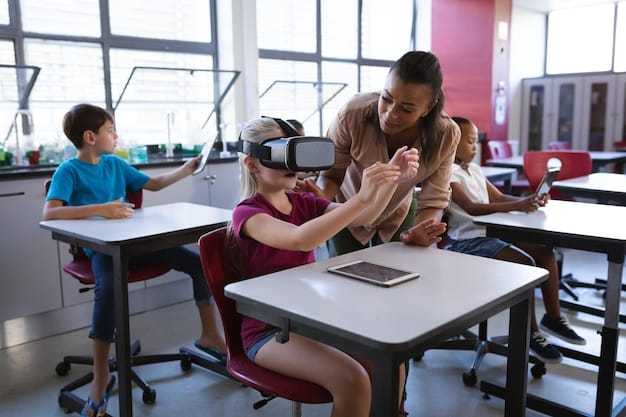Gamified Learning Platforms: Gen Z Effectiveness – Data Analysis

A data-driven analysis reveals that gamified learning platforms for Gen Z students exhibit significant potential in enhancing engagement and motivation, though their effectiveness in direct academic outcomes varies, necessitating targeted design and integration within pedagogical frameworks.
The landscape of education is constantly evolving, perpetually seeking innovative methods to engage younger generations. Amidst this quest, a compelling question arises: How effective are gamified learning platforms for Gen Z students? A data-driven analysis offers crucial insights into this pertinent inquiry. As digital natives, Gen Z possesses unique learning preferences that diverge significantly from previous cohorts, often thriving in interactive, personalized, and technology-rich environments.
understanding gen z’s learning landscape
Generation Z, broadly defined as individuals born between the mid-1990s and early 2010s, represents a cohort deeply immersed in the digital world from an early age. This profound digital native status shapes their expectations, communication styles, and, crucially, their preferred learning methodologies. Traditional didactic approaches often fall short in capturing their attention, which is accustomed to instant gratification, personalized experiences, and constant connectivity.
digital immersion and attention spans
Gen Z’s upbringing in a rapidly evolving technological landscape has cultivated distinct cognitive patterns. Their reliance on smartphones, social media, and streaming services means they are adept at processing information quickly but often in short bursts. This translates to an inclination towards concise, visually rich content over lengthy, text-heavy materials. Their attention spans, while not necessarily shorter, are certainly more selective, demanding immediate relevance and dynamic engagement.
- Visual Learning Preference: Gen Z often processes information more effectively through visual aids, videos, and interactive simulations.
- Instant Feedback Culture: Growing up with instant messaging and social media likes, they expect immediate responses and feedback in educational contexts.
- Personalization Demand: They thrive on experiences tailored to their individual needs, pace, and interests, rather than one-size-fits-all approaches.
the desire for interactivity and agency
Unlike previous generations, Gen Z seeks active participation and control over their learning journey. Passive consumption of information is less appealing; they prefer environments where they can experiment, contribute, and see the immediate impact of their actions. This preference for agency aligns perfectly with the core tenets of gamification, which inherently offers choices, challenges, and consequential actions within a structured system. Their comfort with digital interfaces and interactive elements makes them prime candidates for educational approaches that mirror the dynamic nature of their digital lives, fostering a sense of accomplishment through challenges and rewards.
the fundamentals of gamified learning
Gamification in education involves applying game-design elements and game principles in non-game contexts. This isn’t merely about turning learning into a game; it’s about leveraging the psychological drivers that make games so inherently engaging, translating them into educational settings. The essence lies in understanding what motivates human behavior within game constructs and strategically applying those elements to foster learning outcomes.
core components of gamification
Successful gamified platforms integrate several key elements designed to hook learners and encourage persistence. These components work in concert to create an immersive and motivating learning environment, moving beyond simple points and badges to a more holistic engagement strategy.
- Points, Badges, and Leaderboards (PBL): These are often the most visible elements, providing immediate feedback and fostering a sense of competition or achievement. Points quantify effort, badges recognize specific accomplishments, and leaderboards provide social comparison.
- Quests and Challenges: Structuring learning content as a series of missions or challenges provides clear objectives, enhances narrative, and often involves problem-solving, mirroring real-world application.
- Progress Visualization: Showing learners their progress through levels, unlockable content, or visual bars gives a tangible sense of advancement and encourages continued effort. This addresses Gen Z’s preference for immediate feedback and clear pathways.
- Narrative and Storytelling: Embedding learning within a compelling story or journey can make abstract concepts more relatable and memorable, fostering deeper emotional engagement.
- Choice and Customization: Allowing learners to choose their path, avatar, or learning challenges taps into their desire for autonomy and personalization.
psychological principles at play
The effectiveness of gamification is rooted in several established psychological principles. Behavioral psychology, cognitive psychology, and social psychology all contribute to why these approaches resonate with learners, particular with Gen Z. Elements like self-determination theory, which emphasizes autonomy, competence, and relatedness, are central to the design of successful gamified experiences. The allure goes beyond superficial rewards; it taps into intrinsic motivations.
For instance, the immediate feedback mechanism inherent in gamified systems aligns with the need for competence, showcasing progress and mastery. The element of choice and exploration caters to autonomy, allowing learners to navigate their learning journey in a way that feels self-directed. The social aspects, such as leaderboards or collaborative quests, address relatedness, fostering a sense of community and friendly competition. These deep-seated psychological drivers are what give gamified learning its motivational power, particularly for a generation that values instant gratification and personalized interaction.

data-driven insights: engagement and motivation
Observational studies and quantitative data consistently highlight the strong correlation between gamified learning and increased student engagement, particularly among Gen Z. Engagement, in this context, refers to the degree of attention, curiosity, interest, optimism, and passion that students show when they are learning or being taught. Traditional metrics of engagement, such as time spent on task or participation rates, often see notable upticks on gamified platforms.
increased participation and time on task
One of the most immediate and quantifiable benefits of gamified learning platforms is the visible increase in student participation. Data collected from various educational apps and online courses frequently indicates that students spend more time actively engaging with content when it’s presented in a gamified format. This translates into longer study sessions, more frequent returns to the platform, and a higher completion rate of assignments and modules. For Gen Z, who are accustomed to interactive digital experiences, the gamified approach transforms mundane tasks into enjoyable challenges, reducing the perception of effort and increasing sustained attention.
enhanced intrinsic motivation
While extrinsic rewards like points and badges play a role, research suggests that gamification’s true power lies in its ability to foster intrinsic motivation. When learning is framed as a series of solvable puzzles or achievable milestones, it taps into a student’s natural desire for mastery and competence. Surveys and qualitative feedback from Gen Z students often report heightened levels of enjoyment and a greater sense of purpose in their learning when using gamified platforms. This intrinsic drive is critical, as it encourages self-directed learning and a deeper investment in the educational process, extending beyond the immediate gratification of rewards.
- Challenge and Curiosity: Gamified elements like quests and hidden content pique curiosity, compelling students to explore further.
- Mastery and Competence: Clear progression, skill trees, and level-ups provide tangible evidence of growing mastery, boosting self-efficacy.
- Autonomy and Choice: Giving students choices within the learning path empowers them, making the experience feel less like an obligation and more like a personal journey.
academic performance and learning outcomes
While engagement and motivation are crucial, the ultimate measure of any educational intervention is its impact on academic performance and learning outcomes. Data on this front is more nuanced, indicating that while gamification can be highly effective, its impact is often contingent on careful design and integration within the curriculum. It’s not simply about adding game elements but ensuring they serve a clear pedagogical purpose.
mixed results in direct academic gains
Studies examining the direct correlation between gamified learning and test scores or grades present a mixed picture. Some research shows significant improvements, particularly in subjects requiring repetitive practice or conceptual understanding. For instance, language learning apps or math platforms employing gamification often report better retention and faster skill acquisition. However, other studies find no significant difference or only marginal gains compared to traditional methods for complex, higher-order thinking skills. This suggests that while gamified platforms excel at skill reinforcement and factual recall, their efficacy in encouraging critical analysis or creative problem-solving might depend on more sophisticated design.
the importance of instructional design
The key differentiator between successful and less successful implementations of gamified learning often lies in the instructional design. Gamification is not a magic bullet; it’s a tool. When game elements are seamlessly integrated into the learning objectives, reinforcing core concepts rather than distracting from them, the academic benefits are more pronounced. Effective instructional design ensures that challenges are aligned with learning goals, feedback is constructive, and rewards genuinely signify mastery of content. For Gen Z, who can quickly discern genuine educational value from superficial novelty, well-designed gamification holds greater appeal and yields better results.
Platforms that use gamification to promote spaced repetition, adaptive learning paths, and immediate, corrective feedback tend to show stronger correlations with improved academic performance. The data suggests that gamified platforms are most effective when they provide personalized learning experiences that adapt to the student’s pace and cater to their specific learning gaps, which is particularly appealing to Gen Z’s desire for tailored experiences.
challenges and considerations for implementation
Despite the promising data, embedding gamified learning platforms effectively is not without its challenges. Implementing these systems requires careful planning, a deep understanding of pedagogical goals, and an awareness of potential pitfalls. The nuances of integrating game mechanics into diverse educational settings demand thoughtful consideration to maximize benefits and mitigate drawbacks.
addressing potential pitfalls
One common critique of gamification is the risk of focusing solely on extrinsic rewards, potentially undermining intrinsic motivation. If students are only performing tasks for points or badges, the deeper learning experience can be devalued. Another concern is that overly simplified gamification might trivialize complex subjects, reducing learning to rote memorization rather than fostering critical thinking. It is crucial to design gamified experiences that encourage genuine understanding and application of knowledge, not just superficial engagement. Data also suggests that not all students respond equally to gamification; some may find the competitive aspects demotivating, highlighting the need for flexible approaches.
technical and resource demands
Developing and maintaining high-quality gamified learning platforms can be resource-intensive. It requires significant investment in technology, content creation, and ongoing updates. Educators also need training to effectively integrate these platforms into their curriculum and leverage them to their full potential. The digital divide remains a factor, as access to reliable internet and appropriate devices is not universal, potentially excluding segments of the student population. Ensuring equitable access and providing necessary technical support are critical considerations for widespread adoption. Furthermore, the rapid pace of technological change means platforms can quickly become outdated, necessitating continuous investment in development.
- Cost of Development: Creating engaging and effective gamified platforms often requires substantial financial investment.
- Teacher Training: Educators need specific training to integrate gamified tools effectively and understand their data.
- Accessibility Issues: Ensuring all students have equitable access to technology and internet connectivity remains a challenge.
- Content Longevity: The fast evolution of technology means platform content and features require frequent updates to remain relevant and engaging.
future trends and the evolution of gamified learning
The landscape of gamified learning is continuously evolving, driven by advancements in technology and a deeper understanding of educational psychology. Future trends suggest an even more personalized, immersive, and adaptive experience for Gen Z and subsequent generations. The integration of cutting-edge technologies promises to push the boundaries of what is possible in digital education, making learning more intuitive and engaging than ever before.
adaptive ai and personalized learning paths
One of the most significant future trends is the integration of artificial intelligence (AI) to create truly adaptive gamified learning experiences. AI can analyze a student’s learning patterns, identify areas of strength and weakness, and then dynamically adjust the game, challenges, and content to create a personalized learning path. This level of customization caters perfectly to Gen Z’s demand for tailored experiences, ensuring content is always challenging yet achievable, thereby optimizing engagement and learning outcomes. Data-driven AI can predict when a student might disengage and introduce elements to re-capture attention, making the learning process more seamless.
virtual reality and augmented reality integration
The advent of virtual reality (VR) and augmented reality (AR) holds immense potential for gamified learning. Imagine dissecting a virtual frog in VR, exploring ancient civilizations through AR filters, or solving complex physics problems in a fully immersive digital environment. These technologies can transform abstract concepts into tangible experiences, providing a level of immersion currently unattainable. For Gen Z, who are already familiar with immersive digital worlds through gaming, VR and AR gamified learning could bridge the gap between theoretical knowledge and practical application, making learning more intuitive and memorable by creating powerful, multisensory engagement.
ethical considerations in gamification’s future
As gamified learning evolves, ethical considerations become increasingly important. Questions surrounding data privacy, the potential for addiction, and the equitable distribution of advanced learning technologies need careful attention. Ensuring that these platforms remain tools for empowerment rather than mechanisms for surveillance or exclusion will be crucial. The focus must remain on leveraging gamification to enhance genuine understanding and critical thinking, rather than merely optimizing for engagement metrics. Future development must prioritize responsible innovation, recognizing that while technology offers incredible potential, it must always serve the best interests of the learner.

the role of educators in a gamified environment
In the evolving landscape of gamified learning, the role of educators shifts from being sole content deliverers to facilitators, mentors, and designers of learning experiences. Their expertise becomes even more critical in interpreting data, customizing platforms, and providing the human touch that technology cannot replicate. The success of gamified platforms hinges significantly on how well educators integrate them into a holistic learning journey.
curation and customization
Educators are uniquely positioned to curate and customize gamified content to meet specific curriculum requirements and individual student needs. This involves selecting appropriate platforms, designing complementary activities, and adjusting game parameters to maximize learning outcomes. Their insights into student behavior and learning styles inform how gamified elements are introduced and sustained, ensuring that the technology serves pedagogical goals rather than dictating them. They can identify when a particular gamified module is or isn’t working for a specific student, allowing for timely intervention and adaptation.
- Content Alignment: Ensuring gamified modules directly support and enhance curriculum objectives.
- Individualized Support: Using platform data to identify students needing extra help or more challenge.
- Formative Assessment: Leveraging gamified feedback loops for continuous, low-stakes assessment.
interpreting data and offering personalized feedback
One of the most powerful aspects of gamified platforms is the wealth of data they can generate on student performance, engagement, and progress. Educators play a vital role in interpreting this data, translating raw metrics into actionable insights. This allows them to offer personalized feedback that goes beyond simple scores, addressing specific areas of strength and weakness, and guiding students towards improved understanding. For Gen Z, who value personalized interactions and constructive criticism, this data-driven feedback from an attuned educator can be far more impactful than automated responses, fostering a deeper connection to their learning and demonstrating a real-world application of their efforts within the digital environment.
conclusion
The data unequivocally suggests that gamified learning platforms hold significant promise for engaging Gen Z students, fostering motivation, and, when properly designed, enhancing academic outcomes. Their innate digital fluency and preference for interactive, personalized experiences make them highly receptive to these innovative educational approaches. While challenges remain in implementation, particularly regarding equitable access and robust instructional design, the continued evolution of AI, VR, and AR promises even more immersive and effective learning environments. Ultimately, the effectiveness of these platforms hinges on a synergistic relationship between cutting-edge technology and human pedagogical expertise, ensuring that gamification serves as a powerful tool to cultivate not just knowledge, but a lifelong love for learning among the next generation.
| Key Point | Brief Description |
|---|---|
| 💡 Gen Z Engagement | Gamified platforms excel at capturing Gen Z’s attention due to their digital native preferences for interactivity and instant gratification. |
| 📊 Data-Driven Outcomes | While engagement rises, direct academic gains are nuanced, depending heavily on instructional design and alignment with learning objectives. |
| 🔮 Future Trends | AI, VR, and AR are set to revolutionize gamified learning, offering personalized, immersive, and adaptive experiences. |
| 👩🏫 Educator’s Role | Educators are crucial for curating content, interpreting data, and providing the personalized support that maximizes platform effectiveness. |
frequently asked questions about gamified learning platforms for gen z
Gamified platforms appeal to Gen Z because they are digital natives who thrive on interactive, immediate feedback, and personalized experiences. These platforms mirror the digital environments Gen Z is accustomed to, offering engaging challenges, clear progress, and a sense of accomplishment that aligns with their expectations for dynamic content.
While gamified platforms consistently boost engagement and motivation, their direct impact on academic performance is more nuanced. Data suggests significant improvements in skill acquisition and retention, but for complex, higher-order thinking, effectiveness largely depends on the platform’s instructional design and how well game elements align with core learning objectives, moving beyond superficial rewards.
Key challenges include ensuring equitable access to technology, substantial development and maintenance costs, and the ongoing need for educator training. Additionally, there’s a risk of over-reliance on extrinsic rewards that could undermine intrinsic motivation, and the need to design platforms that foster deep learning rather than superficial engagement.
AI will enable highly adaptive and personalized learning paths, dynamically adjusting content to individual student needs. VR and AR will provide immersive experiences, transforming abstract concepts into tangible, interactive environments. These technologies promise to make learning more intuitive, engaging, and deeply integrated with real-world applications, satisfying Gen Z’s preference for rich, sensory interactions.
Educators are crucial in curating and customizing gamified content, ensuring alignment with curriculum goals. They interpret the wealth of data generated by these platforms to provide personalized feedback and targeted support. Their expertise ensures that gamification serves as a powerful pedagogical tool, guiding students toward genuine understanding and mastery, and offering the human element technology cannot replace.





